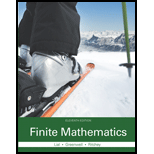
In Exercises 13–27, use the graphical method when the payoff matrix is a 2 × 2 matrix or can be reduced to one after removing rows or columns that are dominated. Otherwise, use the simplex method.
Military Science The Colonel Blotto game is a type of military strategy game. Two opposing armies are approaching two posts. Colonel Blotto has 4 regiments under his command, while his opponent, Captain Kije, has 3 regiments. Each commander must decide how many regiments to send to each post. The army that sends more regiments to a post not only captures that post but also captures the losing army's regiments. If both armies send the same number of regiments to a post, there is a stand-off, and neither army wins. The payoff is one point for capturing the post and one point for each regiment captured. Source: Mathematical Methods and Theory in Games, Programming, and Economics.
(a) Set up the payoff matrix for this game, (Hint: Colonel Blotto has five choices, and Captain Kije has four.)
(b) Find the optimum strategy for each commander and the value of the game.
(c) Show that if Colonel Blotto uses the strategy found, in part (b), then any strategy used by Captain Kije results in the same payoff. (Hint: Show that AM = (14/9)R, where R is a row matrix consisting of all 1's, and then use the fact that RB = [1].)
(d) Based on the result of part (c), what can you conclude about the uniqueness of the optimum strategy found by linear programming?
Want to see the full answer?
Check out a sample textbook solution
Chapter 11 Solutions
Finite Mathematics (11th Edition)
- the set of all preimages of 2 isarrow_forwardWhich diagram(s) represent the following relationships An injective function from A to B? A surjective function from A to B? An injective function from B to A? A surjective function from B to A?arrow_forwardint/PlayerHomework.aspx?homeworkId=689099898&questionId=1&flushed=false&cid=8120746¢erw BP Physical Geograph... HW Score: 0%, 0 of 13 points ○ Points: 0 of 1 Determine if the values of the variables listed are solutions of the system of equations. 2x - y = 4 3x+5y= - 6 x=1, y = 2; (1,-2) Is (1, 2) a solution of the system of equations? L No Yes iew an example Get more help - Aarrow_forward
- Determine if each statement is true or false. If the statement is false, provide a brief explanation: a) There exists x = R such that √x2 = -x. b) Let A = {x = ZIx = 1 (mod 3)} and B = {x = ZIx is odd}. Then A and B are disjoint. c) Let A and B be subsets of a universal set U. If x = A and x/ € A - B,then x = An B.| E d) Let f : RR be defined by f (x) = 1 x + 2 1. Then f is surjective.arrow_forwardWrite the negation of the definition of an injective functionarrow_forwardLet U= {0, 1, 2, 3, 4, 5, 6, 7, 8, 9}, A = {xeU Ix is a multiple of 3}, and B = {x = UIx = 0 (mod 2)}. Use the roster method to list all elements in each of the following sets: a) A, b) B, c) A u B, d) B – A, e) A^cn Barrow_forward
 Algebra and Trigonometry (MindTap Course List)AlgebraISBN:9781305071742Author:James Stewart, Lothar Redlin, Saleem WatsonPublisher:Cengage Learning
Algebra and Trigonometry (MindTap Course List)AlgebraISBN:9781305071742Author:James Stewart, Lothar Redlin, Saleem WatsonPublisher:Cengage Learning College AlgebraAlgebraISBN:9781305115545Author:James Stewart, Lothar Redlin, Saleem WatsonPublisher:Cengage Learning
College AlgebraAlgebraISBN:9781305115545Author:James Stewart, Lothar Redlin, Saleem WatsonPublisher:Cengage Learning

